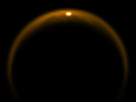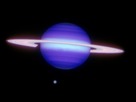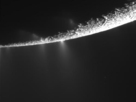Enceladus and Titan
Cassini Double Play
 © NASA/JPL/SSI and NASA/JPL/University of Arizona
|
On the left, Saturn's moon Enceladus is backlit by the sun, showing the fountain-like sources of the fine spray of material that towers over the south polar region. On the right, is a composite image of Titan.
The main scientific goal at Enceladus will be to watch the sun play peekaboo behind the water-rich plume emanating from the moon's south polar region. Scientists using the ultraviolet imaging spectrograph will be able to use the flickering light to measure whether there is molecular nitrogen in the plume. Ammonia has already been detected in the plume and scientists know heat can decompose ammonia into nitrogen molecules. Determining the amount of molecular nitrogen in the plume will give scientists clues about thermal processing in the moon's interior.
The second of Cassini's two flybys is an encounter with Titan. The closest approach will take place in the late evening May 19 Pacific time, which is in the early hours of May 20 UTC. The spacecraft will fly to within 1,400 kilometers (750 miles) of the surface.
Cassini will primarily be doing radio science during this pass to detect the subtle variations in the gravitational tug on the spacecraft by Titan, which is 25 percent larger in volume than the planet Mercury. Analyzing the data will help scientists learn whether Titan has a liquid ocean under its surface and get a better picture of its internal structure. The composite infrared spectrometer will also get its southernmost pass for thermal data to fill out its temperature map of the smoggy moon.
Cassini has made four previous double flybys and one more is planned in the years ahead.
The Cassini-Huygens mission is a cooperative project of NASA, the European Space Agency and the Italian Space Agency. The Jet Propulsion Laboratory, a division of the California Institute of Technology in Pasadena, manages the Cassini-Huygens mission for NASA's Science Mission Directorate in Washington. The Cassini orbiter was designed, developed and assembled at JPL.
Source: NASA
Enceladus and Titan
Cassini Double Play
 © NASA/JPL/SSI and NASA/JPL/University of Arizona
|
On the left, Saturn's moon Enceladus is backlit by the sun, showing the fountain-like sources of the fine spray of material that towers over the south polar region. On the right, is a composite image of Titan.
The main scientific goal at Enceladus will be to watch the sun play peekaboo behind the water-rich plume emanating from the moon's south polar region. Scientists using the ultraviolet imaging spectrograph will be able to use the flickering light to measure whether there is molecular nitrogen in the plume. Ammonia has already been detected in the plume and scientists know heat can decompose ammonia into nitrogen molecules. Determining the amount of molecular nitrogen in the plume will give scientists clues about thermal processing in the moon's interior.
The second of Cassini's two flybys is an encounter with Titan. The closest approach will take place in the late evening May 19 Pacific time, which is in the early hours of May 20 UTC. The spacecraft will fly to within 1,400 kilometers (750 miles) of the surface.
Cassini will primarily be doing radio science during this pass to detect the subtle variations in the gravitational tug on the spacecraft by Titan, which is 25 percent larger in volume than the planet Mercury. Analyzing the data will help scientists learn whether Titan has a liquid ocean under its surface and get a better picture of its internal structure. The composite infrared spectrometer will also get its southernmost pass for thermal data to fill out its temperature map of the smoggy moon.
Cassini has made four previous double flybys and one more is planned in the years ahead.
The Cassini-Huygens mission is a cooperative project of NASA, the European Space Agency and the Italian Space Agency. The Jet Propulsion Laboratory, a division of the California Institute of Technology in Pasadena, manages the Cassini-Huygens mission for NASA's Science Mission Directorate in Washington. The Cassini orbiter was designed, developed and assembled at JPL.
Source: NASA















